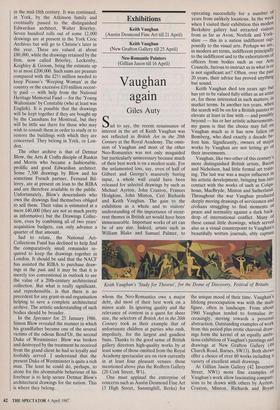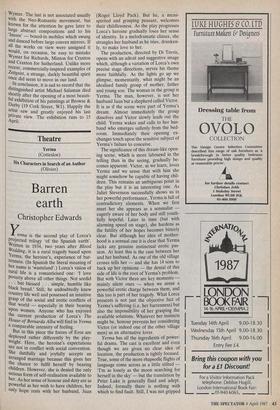Exhibitions
Keith Vaughan (Austin Desmond Fine Art till 21 April) Keith Vaughan (New Grafton Gallery till 25 April) Neo-Romantic Painters (Gillian Jason till 16 April)
Vaughan again
Giles Auty
Sad to say, the recent renaissance of interest in the art of Keith Vaughan was not reflected in British Art in the 20th Century at the Royal Academy. The omis- sion of Vaughan and most of the other Neo-Romantics was not only misguided but particularly unnecessary because much of their best work is on a modest scale. For the unlamented loss, say, even of half of Gilbert and George's massively boring input, a whole wall could have been released for selected drawings by such as Michael Ayrton, John Craxton, Frances Hodgkins, John Minton, Ceri Richards and Keith Vaughan. The gain to the exhibition as a whole and to visitors' understanding of the importance of recur- rent themes in British art would have been immeasurable. Important works of art can be of any size. Indeed, artists such as William Blake and Samuel Palmer, to Keith Vaughan's 'Study for Theseus', for the Dome of Discovery, Festival of Britain.
whom the Neo-Romantics owe a major debt, did most of their best work on a minor scale. In ignoring quality and the relevance of content in a quest for sheer size, the selectors of British Art in the 20th Century took as their example that of unfortunate children at parties who rush, impolitely, for the largest and gaudiest buns. Thanks to the good sense of British gallery directors high-quality works by at least some of those omitted from the Royal Academy spectacular are on view currently in at least four pleasant venues: those mentioned above plus the Redfern Gallery (20 Cork Street, W1).
One must applaud the enterprise of concerns such as Austin Desmond Fine Art (3 High Street, Sunninghill, Berks) for operating successfully for a number of years from unlikely locations. In the week when I visited their exhibition this modest Berkshire gallery had attracted visitors from as far as Avon, Norfolk and York- shire — this in a nation indifferent sup- posedly to the visual arts. Perhaps we are, in modern art terms, indifferent principally to the indifferent and to the exhortations of officers from bodies such as our Arts Councils, furious to instruct us in what is or is not significant art? Often, over the past 20 years, their advice has proved anything but sound.
Keith Vaughan died ten years ago but has yet to be valued fully either as an artist or, for those interested in such matters, in market terms. In another ten years, when the search will be on for a British painter to elevate at least in line with — and possibly beyond — his or her artistic achievements, my guess is that the choice may fall on Vaughan much as it has now fallen on Bomberg, who died exactly a decade be- fore him. Significantly, owners of major works by Vaughan are not letting go of their investments.
Vaughan, like two other of this century's more distinguished British artists, Bacon and Nicholson, had little formal art train- ing. The last war was a major influence in his artistic development, bringing him into contact with the works of such as Coign- houn, MacBryde, Minton and Sutherland. Throughout the war Vaughan produced deeply moving drawings of servicemen and civilians struggling to find moments of peace and normality against a dark back- drop of international conflict. Many of these casual little drawings, which served also as a visual counterpoint to Vaughan's beautifully written journals, ably capture the unique mood of their time. Vaughan's lifelong preoccupation was with the male figure, often in landscape. From about 1960 Vaughan tended to formalise in- creasingly, moving towards a personal abstraction. Outstanding examples of work from this period plus erotic charcoal draw- ings form the kernel of an equally ambi- tious exhibition of Vaughan's paintings and drawings at New Grafton Gallery (49 Church Road, Barnes, SW13). Both shows offer a choice of over 80 works including a variety of excellent small drawings. At Gillian Jason Gallery (42 Inverness Street, NW1) more fine examples of Vaughan's work allow fascinating compari- sons to be drawn with others by Ayrton, Craxton, Minton, Richards and Bryan Wynter. The last is not associated usually with the Neo-Romantic movement, but known for the attention he gave later to large abstract compositions and to his Imoos' — boxed-in mobiles which swung and danced before large convex mirrors. If all the works on view were unsigned it would, on occasion, be easy to mistake Wynter for Richards, Minton for Craxton and Craxton for Sutherland. Unlike more recent, commercially-inspired examples of Zeitgeist, a strange, darkly beautiful spirit once did seem to move in our land. In conclusion, it is sad to record that the distinguished artist Michael Salaman died shortly after the opening of a most beauti- ful exhibition of his paintings at Browse & Darby (19 Cork Street, W1). Happily the artist saw and greatly enjoyed his last private view. The exhibition runs to 15 April.



























































 Previous page
Previous page